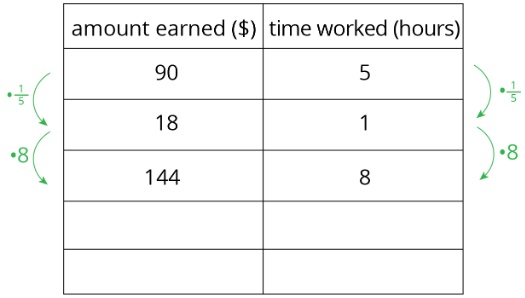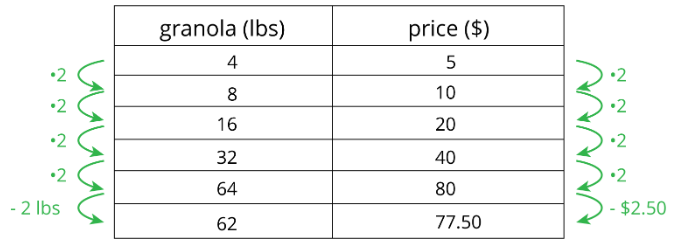12.2: Navigating a Table of Equivalent Ratios
- Page ID
- 39932
Lesson
Let's use a table of equivalent ratios like a pro.
Exercise \(\PageIndex{1}\): Number Talk: Multiplying by a Unit Fraction
Find the product mentally.
\(\frac{1}{3}\cdot 21\)
\(\frac{1}{6}\cdot 21\)
\((5.6)\cdot\frac{1}{8}\)
\(\frac{1}{4}\cdot (5.6)\)
Exercise \(\PageIndex{2}\): Comparing Taco Prices
Use the table to help you solve these problems. Explain or show your reasoning.
- Noah bought 4 tacos and paid $6. At this rate, how many tacos could he buy for $15?
- Jada’s family bought 50 tacos for a party and paid $72. Were Jada’s tacos the same price as Noah’s tacos?
| number of tacos | price in dollars |
|---|---|
Exercise \(\PageIndex{3}\): Hourly Wages
Lin is paid $90 for 5 hours of work. She used the table to calculate how much she would be paid at this rate for 8 hours of work.

- What is the meaning of the 18 that appears in the table?
- Why was the number \(\frac{1}{5}\) used as a multiplier?
- Explain how Lin used this table to solve the problem.
- At this rate, how much would Lin be paid for 3 hours of work? For 2.1 hours of work?
Exercise \(\PageIndex{4}\): Zeno's Memory Card
In 2016, 128 gigabytes (GB) of portable computer memory cost $32.
- Here is a double number line that represents the situation:

One set of tick marks has already been drawn to show the result of multiplying 128 and 32 each by \(\frac{1}{2}\). Label the amount of memory and the cost for these tick marks.
Next, keep multiplying by \(\frac{1}{2}\) and drawing and labeling new tick marks, until you can no longer clearly label each new tick mark with a number.
- Here is a table that represents the situation. Find the cost of 1 gigabyte. You can use as many rows as you need.
memory (gigabytes) cost (dollars) \(128\) \(32\) Table \(\PageIndex{2}\) - Did you prefer the double number line or the table for solving this problem? Why?
Are you ready for more?
A kilometer is 1,000 meters because kilo is a prefix that means 1,000. The prefix mega means 1,000,000 and giga (as in gigabyte) means 1,000,000,000. One byte is the amount of memory needed to store one letter of the alphabet. About how many of each of the following would fit on a 1-gigabyte flash drive?
- letters
- pages
- books
- movies
- songs
Summary
Finding a row containing a “1” is often a good way to work with tables of equivalent ratios. For example, the price for 4 lbs of granola is $5. At that rate, what would be the price for 62 lbs of granola?
Here are tables showing two different approaches to solving this problem. Both of these approaches are correct. However, one approach is more efficient.
- Less efficient

- More efficient

Notice how the more efficient approach starts by finding the price for 1 lb of granola.
Remember that dividing by a whole number is the same as multiplying by a unit fraction. In this example, we can divide by 4 or multiply by \(\frac{1}{4}\) to find the unit price.
Glossary Entries
Definition: Table
A table organizes information into horizontal rows and vertical columns. The first row or column usually tells what the numbers represent.
For example, here is a table showing the tail lengths of three different pets. This table has four rows and two columns.
| pet | tail length (inches) |
|---|---|
| dog | \(22\) |
| cat | \(12\) |
| mouse | \(2\) |
Practice
Exercise \(\PageIndex{5}\)
Priya collected 2,400 grams of pennies in a fundraiser. Each penny has a mass of 2.5 grams. How much money did Priya raise? If you get stuck, consider using the table.
| number of pennies | mass in grams |
|---|---|
| \(1\) | \(2.5\) |
| \(2,400\) |
Exercise \(\PageIndex{6}\)
Kiran reads 5 pages in 20 minutes. He spends the same amount of time per page. How long will it take him to read 11 pages? If you get stuck, consider using the table.
| time in minutes | number of pages |
|---|---|
| \(20\) | \(5\) |
| \(1\) | |
| \(11\) |
Exercise \(\PageIndex{7}\)
Mai is making personal pizzas. For 4 pizzas, she uses 10 ounces of cheese.
| number of pizzas | ounces of cheese |
|---|---|
| \(4\) | \(10\) |
- How much cheese does Mai use per pizza?
- b. At this rate, how much cheese will she need to make 15 pizzas?
Exercise \(\PageIndex{8}\)
Clare is paid $90 for 5 hours of work. At this rate, how many seconds does it take for her to earn 25 cents?
Exercise \(\PageIndex{9}\)
A car that travels 20 miles in \(\frac{1}{2}\) hour at constant speed is traveling at the same speed as a car that travels 30 miles in \(\frac{3}{4}\) hour at a constant speed. Explain or show why.
(From Unit 2.3.5)
Exercise \(\PageIndex{10}\)
Lin makes her favorite juice blend by mixing cranberry juice with apple juice in the ratio shown on the double number line. Complete the diagram to show smaller and larger batches that would taste the same as Lin's favorite blend.

(From Unit 2.3.1)
Exercise \(\PageIndex{11}\)
Each of these is a pair of equivalent ratios. For each pair, explain why they are equivalent ratios or draw a representation that shows why they are equivalent ratios.
- \(600:450\) and \(60:45\)
- \(60:45\) and \(4:3\)
- \(600:450\) and \(4:3\)
(From Unit 2.2.3)

